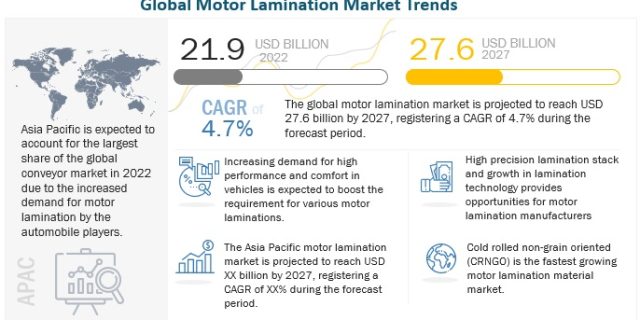
The motor lamination market is estimated to grow from USD 21.9 billion in 2022 to reach USD 27.6 billion by 2027 at a CAGR of 4.7% during the forecast period. The market growth is seen mainly due to the growing demand for luxury vehicle sales across different geographies. Growing safety standards and increased demand for comfort applications are also boosting the demand for motors and lamination stacks globally.
Transition to e-mobility solutions and increase in usage of electric motors will drive the motor lamination market
Environmental degradation and air pollution are the major concerns faced by the world today. Growing awareness of the harmful effects of vehicular emissions has forced automotive manufacturers to develop vehicles that comply with regional regulatory standards. Increasing stringency of emission norms has resulted in increased sales of electric vehicles such as BEVs, HEVs, and PHEVs. According to data from the Federation of Automobile Dealers Associations, retail electric vehicle (EV) sales increased threefold in 2021–22 (April-March) (FADA). Also, despite supply chain bottlenecks and the ongoing Covid-19 pandemic, electric car sales set a new high in 2021. Sales nearly doubled to 6.6 million (a sales share of nearly 9%) compared to 2020, bringing the total number of electric vehicles on the road to 16.5 million. With the increasing demand for electric vehicles, the demand for certain stacks will register an increase simultaneously, considering the increasing demand for performance motors with advanced silicon-based materials and high-performance electrical steels for motor laminations. All these factors substantiate the growth in demand for motors and, subsequently, the lamination technologies, which will drive the market growth.
Download PDF Brochure @ https://www.marketsandmarkets.com/pdfdownloadNew.asp?id=117324037
Advancement in lamination technologies with better operational efficiency
Lamination sheets are magnetic metal sheets with properties that exhibit higher operational effectiveness under various conditions. The quality of lamination sheets depends on the output of an electric motor. With time, the technology of manufacturing lamination sheets has undergone many changes to reduce fabrication costs and operational time. Techniques such as bonding, stamping, and welding are mainly used to make lamination sheets. The rotor and stator can be made from the same material with the help of precision techniques. The full bond technique and dots technology/ glulock are expected to impact the lamination market significantly. The developments in lamination technologies with better performance will drive the demand for motor laminations during the forecast period.
Asia Pacific is likely to be the largest market during the forecast period
Asia Pacific has emerged as a hub for automotive production in recent years. The increasing production of vehicles is the region are primarily attributed to the facilitative regulatory policies of the government like ‘Make in India’. Countries like China has emerged as the leading export hub for vehicle production due to availability of cheap capital, raw materials and skilled labour force to cater to the needs of other regions. Nearly all the major automation and additions for performance, safety, and comfort in vehicles are primarily driven by motors, which indicates that the demand for motor lamination will pick up in sync with the demand for motors. Thus, considering the above factors, it is evident that the motor lamination market is expected to grow significantly in the coming years.
Key Market Players
Tempel (US), Pitti Engineering Ltd (India), Alinabal, Inc (US), EuroGroup Laminations S.p.A. (Italy), R. Bourgeois (France), and LCS Company (US).
Request Free Sample Report @ https://www.marketsandmarkets.com/requestsampleNew.asp?id=117324037

